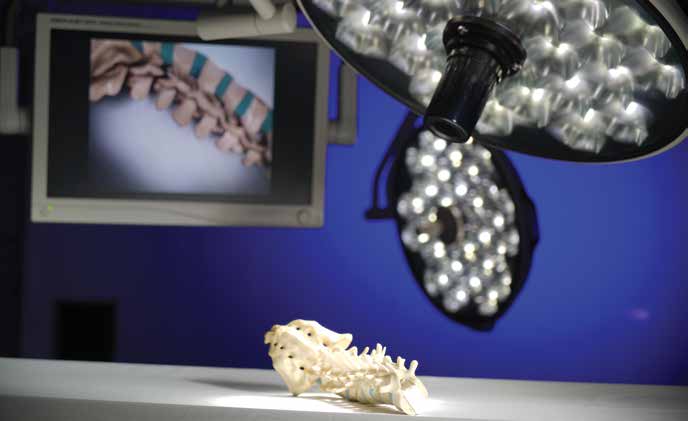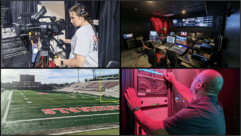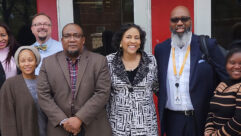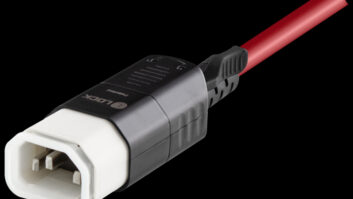

SVC: The more I read about this massive AV tech upgrade in your surgical skills lab there, the more fascinating it got especially when I learned that it was all done in-house by the same faculty members who are using the lab. It sounds like you’ve got some very special people there, so tell us about Macquarie University.
Iain Brew: Sure. Well, thanks for having me. I’m the Clinical AV and IT coordinator for the Faculty of Medicine and Health Sciences at Macquarie University. We’re quite a young university. We were founded in 1964. We’re located in Macquarie Park, which is sort of in the northern part of Sydney. Some quick facts about us: we’ve got over 40,000 students and we also have our very own private hospital on our campus, which is quite a rare thing. As I said I work for the Faculty of Medicine and Health Sciences and to help support, amongst other things, our surgical skills lab. I guess one way to think of the surgical skills lab is like having 10 operating theaters in one massive room. And we use that space with our medical community and students to explore things like human anatomy and demonstrate surgical skills and techniques. In the last few years we’ve trained over 1,500 physicians from all around the world in that space. The space itself has quite a few challenges. So, for example, we can have up to 60 people in a relatively conservative-sized space. So in terms of AV it’s really important that we have some clarity for audio and also the ability to see clear pictures wherever you are in the lab.

Before jumping into the deep end of the pool with this, had you done any previous AV projects or installations at the university?
This is the largest thing I’ve done with the university. In the past I’ve done a few other projects. We had, in 2010, a digital signage pilot and I got involved with that and helped design a large 3 x 3 video wall for our new library at the time. And I used some video over IP products back then which was quite exciting. Moving on from the success of that installation I was engaged to design a self-service media studio for academics. Media and video content and multimedia is becoming more and more important in our education, but in terms of generating that content there’s only a handful of professional media people on the campus that can do it. So we wanted to empower our academics to be able to do it themselves. So I built this space for them that uses an iPad controller and that went very well. And so when I moved across into medicine I did a small meeting room upgrade. That inspired some confidence which then allowed me to do a small control and audio upgrade of our simulation lab, which inspired further confidence, which then opened the doors to allow me to do a complete refresh of a larger space.
What was the problem with the previous AV system in the lab?
The previous system was installed when the building was originally built in 2010 and unfortunately hadn’t been touched since. So it’s a proprietary system that never quite worked the way anyone wanted it to work. So for example, there’s very limited routing and control capability. So as I mentioned, it’s sort of 10 operating theaters in one big room so each operating theater has a surgical-grade, full high-definition monitor, inputs, and a speaker. And that’s replicated 10 times. However, there’s a teaching station and that could only route S-video to the other displays. That was it. That was the limit of our routing capability previously. So we would have a situation where the teacher or the demonstrator would be showing a technique on a model or something along those lines and then want to show all the students or scholars in the class. So our poor lab coordinators would have to go around to each and every display and change the input by hand. Then when the demonstration was finished go back and do it all again to go back to local inputs. So that wasn’t great. And in terms of inputs there was analog routing throughout the entire facility, so there was no unified signal format. Every display had S-video, DVI via fiber, VGA and SDI and control so there were just cables everywhere. We pulled out two cubic meters of cabling and there’s still plenty left in the roof.
Along those lines, in terms of cabling we often had challenges with newer computers and high-definition sources, which weren’t as popular back in 2010. We had a lot of EDID issues, things not syncing properly or syncing at weird resolutions or not high resolutions. Even though we had a high-definition display we could never get a high-definition picture out on it. And due to the cost of the system and the cost of the proprietary control system, we would have to go and get a dedicated programmer if we wanted to make a change or improvement. And that was quite a prohibitive cost. So as a result, like I said before, things didn’t get upgraded, problems didn’t get solved, and it just slowly broke down over time, especially because we don’t own the source code for the system. So we thought right, it’s time for a change. Let’s do something better.
That would really complicate things if you can go out and buy something of a different make and model but not be able to program the system to control it or make it work.
That’s right. And it was quite an expensive system as well, so it was quite disappointing that we were sort of left in a situation where we couldn’t just jump in and make a change ourselves. But it’s one of those systems where you need to have accreditation and years of training before you’re even allowed to be let loose on those systems. So it doesn’t quite work the way we work anymore.
Yeah and I can imagine how the S-video looked running around through all of those high current systems, putting out induction fields. It was far from the best in showing the high detail that they need to have in the lab.
That’s right. So for S-video, we have a lot of medical equipment which has quite a lot of output options on it. S-video is probably the lowest-quality output available in those devices. It works, and we do get a reasonably decent picture, but you put a picture from that next to a high-definition output on the screen there’s just no comparing them. We didn’t really have much interference, which was quite a surprise for me when I first started working in the space. The signals themselves were fairly decent quality. The cabling was really top-notch, Belden, good stuff, so I’m not surprised we didn’t have that much interference. But it was more the actual picture quality itself – soft, lack-of-detail. For what we’re doing that’s not really going to cut it.
I was looking at some of the images in detail and it looks like you had an NEC projector on the ceiling for the big view in the room. Was that new or a part of the existing system?
That projector was existing. It replaced a projectiondesign F12 back when the building was built. The F12 wasn’t quite cutting it at the time because it’s an incredibly bright space. It’s full of fluorescent lighting and also there’s ten medical lights. And one entire side of our lab is just natural light coming in from windows. So they replaced it with the NEC PA-550 projector— now we have 5,000 lumens, 1280 x 800. Originally it had a whole ton of connections feeding into it for all different signal types in the lab, however now we’ve just replaced it with one single CAT network cable with a video over IP receiver which just feeds a full HD signal in via HDMI no matter what our input is. So it’s really cleaned up the roof space.
It’s remarkable that you were able to use that much existing equipment and blend it with the new high-resolution video distribution. But the most remarkable thing about it to me was the fact that you didn’t call in an AV contractor for this. The entire project was handled by faculty members who will be using the new setup.
That’s right. When I joined the faculty last year in 2016, I did a full audit of the system – every nut and screw and bolt and every piece of equipment. I talked to all our faculty stakeholders—our Director of the Lab Associate, Professor Richard Appleyard; our Surgical Skills Coordinator, Dr. Janos Tomka; and also students, teaching staff, professional staff. I formed sort of a refresh plan for our faculty. And so the first cab off the rank was our surgical school. That’s where we identified the strongest need for improvement. I designed all the systems and sort of engaged with different companies to look at different products, attended tradeshows. Just called people up and like, “Hey, can I look at your product. Can you send one out to me for a week?” And it was quite great that companies would respond to that. There was a bit of surprise that I’m not an integration company, but never mind. Once the project got some budget and got some legs we bought all the equipment ourselves and like I said, we all pitched in so we were up ladders pulling old cabling out of pendants and designing new wall input panels and things like that with our hospital facilities team. That saved a lot of money as well, but it means that I think we take a lot of pride in the work we’ve done because we did most of it ourselves. So it’s something we’re very excited about.

It would seem that the faculty members, since they installed all of this, would have a big start on how to operate everything. They can control all of these video sources and distribution on an iPad Pro tablet?
I’m using a product from a Russian company called iRidium Mobile. I’ve been very impressed with their software. I’ve used other products in the past, that were useful, but just not very powerful. This iRidium software I feel is as good or even better than the other big players in the market such as AMX or Crestron. So for our installation in this lab I’m using an iPad Pro 12.9 inch, which we have wall mounted onto a panel of wood. Something I’ve done a little bit differently is instead of using Wi-Fi for the iPad we’re actually using an Ethernet—that way I’ve got a very secure connection back to the control systems. One of the concerns about Wi-Fi for me is if it drops out or the iPad loses a connection then our entire lab stops working. So I’m using an Ethernet adapter—it was a new thing for me to find that the iPads can actually support it.
In terms of the software, we’re using Version 3 of the software. It’s the latest version. It works as a Windows program and it’s a what-you-see-is-what-you-get type interface. So you create pages and popups. On those pages you can drag graphics from the program yourself. For us, I use Photoshop to make all my buttons and headings and titles and control things mainly just so that it would be on our new brand and have the same colors and look as the university. And then on the right-hand side of the interface you have all your devices, commands, syntax and tokens, which you use for logic and things like that. It’s all drag-and-drop and you can also get under the hood because really the whole thing is just JavaScript. It can be deployed to any IOS device, any Android device, and any Windows device. So I can build one control system and roll it out to multiple different devices without having to change a thing.
And you only had something like six weeks to get the job finished?
Our surgical skills lab is one of the most heavily-used labs in the southern hemisphere, actually, so there’s not a lot of downtime. So there was a lot of preplanning, a lot of prework and testing prior the build. But the actual build—it’s a date that is probably ingrained into my memory forever now: Monday, 19th of December 2016 is when we started pulling roof tiles out and ripping old pieces of equipment out. And then six weeks later, sort of mid-January this year, we were up and running. Of course there were a few little bugs or little things to sort out, but within a six-week period we went from the old lab to a completely new space.
You certainly did a great job on the wiring. I’ve seen some of the pictures and with all of that high tech gear all over that room, I barely see a wire anywhere. With all those moving arms and swiveling platforms, that must have been a real job threading cable through all that.
That was a challenge because we’ve never done that before. We were kind of figuring it out as we went along. Luckily we have a biomechanical engineer who was very helpful in figuring things out for us. The first one we did, it took about four hours and three people to try and wrap the cable through these impossible small, little channels and little elbows and armatures throughout the whole system. But we became quite good at it in the end.
And I take it you got fairly good support from the equipment companies like Gefen and the others.
That’s right. Like I mentioned, the heart of our system is iRidium Mobile. I had some great support from Jackie Roos at JAMWARE, New Zealand, who is our distributor for iRidium back in Russia. Lots of emails and questions and, “Can I do this?” and “How do I do that?” and things, but she was fantastic. Our video system is all over IP so I feel that’s the way the AV industry is moving now. Everything is going on IP rather than dedicated analog or digital cables. I selected the Gefen video over IP, which is quite new and I worked very closely with Rod Sommerich here in Sydney, Australia and he gave us incredibly great support. Sort of June and July last year he provided loan equipment and came out for a few days and answered questions and went over my plans and helped me design things – and helped with the networking side of things. And did absolutely fantastic. So I really recommend to people looking for video over IP products definitely give Gefen a go.
You changed over to all IP video distribution. Was that the primary technical upgrade you did?
I think our highest priority was to improve the control of what we had. However, as we went deeper into the project we realized that we really needed to start thinking about the quality of our audio and video as well, so we did it as a coherent project. In order to do so we needed a new matrix—we have so many inputs and outputs in the space that was going to get very expensive very fast. And I also wanted something that was going to be scalable for other upgrades we might be doing in our building, so that we can link everything together with a common system. Video over IP was the logical step for us. I looked at a few different products. The thing that stood out for me for the Gefen solution was their matrix controller. It’s a piece of hardware that sits on the network that can receive simple routing commands and then that figures out all the complicated multicasting and network configuration for you. So it’s very, very easy to program, compared to other products where you have to actually talk to the switch itself by logging into its console and reaching its V-LAN.
The Gefen product seemed to be the logical solution, and the other thing I like about it is it’s highly scalable. I think from their web site you can have up to 65,000 devices. I hope we never reach that number. That would be quite a mess of work to look after. But the other great thing is that they’ve just released their new ultra-high definition products, but it’s backwards compatible with the high definition products that we’ve bought. So in a year’s time, when we do something in another part of the building, we don’t have to rip everything out and start again. They will talk to each other. I think that’s fantastic that our investment is protected and future-proofed.

I know sustainability was central to this project. You didn’t just rip out all of the old stuff and throw it in the trash. What was your plan to implement sustainability?
Sustainability is something that’s very important to me personally. At the university I actually worked for eight years in the Macquarie University Sustainability Department led by Director Leanne Denby. I take a holistic approach to working and it’s something that is ingrained in everything I do with the university. People might think with technology and AV: how can it be sustainable?
I sort of used the three R principal. So that was reduce, reuse, and recycle. So for example, in the reduce category, I chose a component system. I only have to buy the boxes that I need today to make the system work. I don’t have to buy a 32 x 32 or 64 x 64 matrix with half the capabilities never used, which has happened in the past. Now if I want to add capability I just add a second network switch, which is quite expensive, but I’ve got an additional 48 interface ports which is fantastic. And also by switching to an IP-based system, I have a lot less cabling and a lot less burden.
In terms of reusing, there’s a lot of stuff in our lab that’s still working perfectly fine; all the speakers, amplifiers, the existing projector, the existing medical displays amongst a few other bits and pieces. So we were able to integrate that into our new equipment and new control system. And in terms of recycling, like I mentioned we pulled out two cubic meters of cable through the roof. That will all get sent away and all the metal stripped out and recycled. All the packaging we used was recycled. Dr. Janos Tomka’s son, Adam, came in actually during the school holidays and he was fantastic pulling boxes apart and separating things for us. And Gefen was quite good on that. Normally when you buy a technical device these days they’re built for an international market so you end up with a box of every international plug under the sun. Of course we only need the Australian plug. For all the other plugs, Gefen actually takes those back and can reuse them elsewhere in the world. So it was fantastic that considering the amount of products we bought we saved a lot of stuff going to landfill.
The lab looks remarkably uncluttered. Where is all of the rack equipment located?
It’s disappointing sometimes. I bring people in and they’re like, “We can’t see anything. It’s all hidden.” It’s all hidden behind the surgical monitors up in the plenum space. But the heart of the system is located in a storeroom next door to the lab. That’s where the existing AV system was, so there were already cable trays and cable paths, so it made sense to bring everything back to that space. But it also keeps it out of sight and out of mind and also secure.
One of the items of equipment that got my attention was the Behringer digital sound mixer. I went to their site and it looks like a mixer that you would more likely find in a performance venue or recording studio. How do you use the Behringer X32?
Well, the short answer is we use it in an unorthodox fashion. I’ve used the Behringer X32 console in another project for the university—I look after all the live streaming of our graduation ceremonies and we use an X32 to manage all the sound for that. And I found it to be very powerful and very versatile, but also very cost-effective. It offers 32 channels in, 16 channels out, heaps of processing power both on inputs bus connection points and outputs. So I thought when we built this lab: I wonder if I could use the X32?
When I went to the Integrate Expo, which is held here in Australia, I went up to the Behringer guys and I said here’s what I want to do. They said you’re not the first person to ask this question. That gave me a bit of confidence that I could probably pull this off. I did a lot of testing with the X32 console that we own and I discovered somebody’s published online an OSC library so basically any control you can have on the X32 can actually be controlled via UDP commands over a network. Since I don’t need to do anything too complicated— some muting, routing changes, and volume control—I was able to replicate all those functionalities from the iRidium control software. When I was programming the system I could actually get my big console, digitally link it back to the rack so I could sit in the lab itself and fine-tune the audio and sweeten the sound while actually sitting there. I didn’t have to hide in a storeroom with a laptop and run backwards and forwards with test material.
The increased detail you now have on the monitors would seem to come in very handy when you’ve got arthroscopes and microscopes connected among the video sources.
For our medical displays we have Stryker Vision Elect 26” medical displays, which were the existing products installed when the lab was built. We have all sorts of medical equipment and sometimes medical equipment can have quite funky EDIDs. So the Gefen products have handled that quite well. We had a few endoscope products that when we connected DVI to HDMI into the Gefen boxes it just wasn’t playing nice, so we used SDI to HDMI adapters. We’ve put 10 of those throughout the lab so if you’re using a piece of medical equipment, we recommend that people connect via SDI, so it’s standards-based 1080p signal. That feeds through the converter into the HDMI system and delivers beautiful pictures wherever we need them. We have endoscopes, we have arthroscopes, C-arm x-ray machines. Of course the medical community that come to use our lab will bring all sorts of interesting things like medical robots. We’re seeing a lot more 3D things come in, ultrasound machines. And there’s more and more demand now for medical equipment to have high-quality video outputs so that it’s easy to share and record information from those devices.
And once you did get the whole system up and running how long did it take to get everybody trained and ready to use it?
Training wasn’t too hard. Because we’ve all been involved in the upgrade process we all know the system quite well. And the same thing with the control system. When we first started, I printed out a picture of an iPad with a white screen. We would actually draw everything out together. So I would say here’s some ideas and we’d scribble and draw and only when we were happy did everything go off into the computer and we’d actually start building it. So people were already familiar with the control system because it was the lab users themselves who directed how they wanted it to look and feel.
In terms of training I have done some basic training with our lab users and we look at it as if there are two levels. When you first turn the system on, it gives you a bunch of presets for our most common use of the lab. All they have to do is push start, wait for the system to turn on, and then push a preset. Within one to two clicks they can actually get the lab set up and then they can just forget about it and go about their teaching or research. However, you can go deeper. We’ve got pages where you can route any video source and view your destination, same with audio, streaming, recording and also room control—so blinds, projector screens, blanking of screens, also control over the Apple TV we use for wireless presentation. For all those other things when I’m not around, I made a little booklet that staff can access to quickly get a rundown on it. It’s sort of a cheat sheet on “I want to do this thing, how do I do it?” So far so good. Everyone’s been very happy with it.









